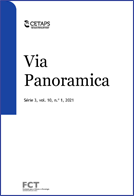Alegoria Distópica da Contemporaneidade e Biopolítica em The Childhood of Jesus (2013), de J.M. Coetzee
Abstract
The first novel The Childhood of Jesus (2013) from the last trilogy published by JM Coetzee, followed by The Schooldays of Jesus (2016) and The Death of Jesus (2019), inaugurates a dystopian and purposefully organized ―New World‖ by creating an atmosphere of control from government institutions in this country. As a result, the narrative suggests a democracy that functions in a regulated manner and which relates in a similar way to contemporary times. The purpose of this article is to analyze how dystopia and biopolitics are present in the novel and how, based on these concepts, an allegory is made in relation to contemporaneity. It follows closely the definitions of ―dystopia‖ and ―ustopia‖ through Jacoby (2000) and Atwood (2011) and of ―biopolitics‖ through Foucalt (1979).
Downloads
Published
How to Cite
Issue
Section
License
Copyright (c) 2021 Via Panoramica: Revista de Estudos Anglo-Americanos

This work is licensed under a Creative Commons Attribution-NonCommercial 4.0 International License.




